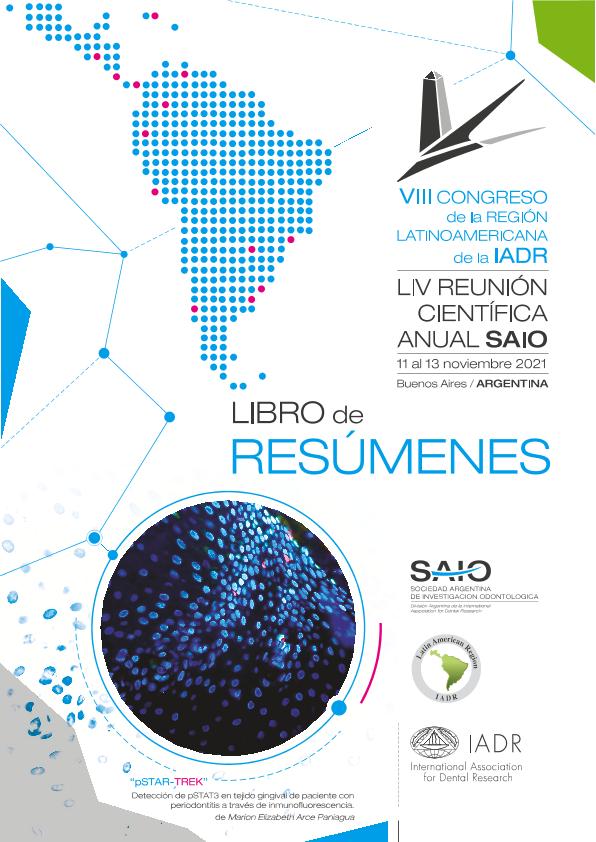Evento
El objetivo del presente trabajo fue evaluar la liberación in vitro de rh-PTH 1-34, a partir del biomaterial desarrollado. Y estudiar in vivo, la capacidad regenerativa del mismo en un modelo de defecto de tamaño crítico (CSD) en calota de conejos. MATERIALES Y MÉTODOS: In vitro: El péptido se cuantificó mediante electroquimioluminiscencia (Cobas 6000 Equipment, Roche Diagnostics), en intervalos de tiempo: 0, 4, 8, 24, 72, 96 y 120 horas; con una concentración final de 30 µg / 4,5 mg y pH 7,4. In vivo: En 20 conejos neozelandeses, 6 meses, 3,5 kg ± 500 gr, se realizó colgajo mucoperióstico y CSD (15 mm Ø) central en calota. Los animales se dividieron en grupo control (GC) sin tratamiento y grupo experimental (EG) tratados con nuevo biomaterial. Los sacrificios fueron a los 45 y 90 días. El diagnóstico por imágenes se hizo mediante tomografía computarizada Cone Beam (CBCT). Se realizaron estudios histopatológicos en muestras descalcificadas utilizando cortes orientados y tinción con H&E, Tricrómico de Massón y AB-Pas. Además, se trabajó con secciones sin descalcificar e incluidas en metilmetacrilato (MMA) desgastadas y se evaluaron mediante luz transmitida, luz polarizada y microscopía de fluorescencia. Las imágenes digitales obtenidas por Soft CellSens 1.16, fueron analizadas morfométricamente por el software Image ProPlus. Se seleccionó la prueba de Mann Whitney (Minitab 17) para el análisis de datos estadísticos. RESULTADOS: La liberación de rh-PTH 1-34 desde el biomaterial se confirmó hasta 96 hs. Los resultados radiométricos por CBCT fueron: GC 45d y 90 del 20% y 32% de regeneración ósea respectivamente, mientras que el GE obtuvo 43% a 45 d y 73% a 90 d. Los resultados histométricos fueron: GC a 45d y 90 d, 16% y 22% de hueso nuevo respectivamente; y GE obtuvo un 45% a 45 d y 85% a 90 d. Se encontraron diferencias significativas entre los grupos seleccionados (p<0,05). CONCLUSIÓN: Los resultados obtenidos sostienen la capacidad regenerativa ósea de la matriz bioingenierizada, promoviendo su rol potencial para el tratamiento de pérdidas óseas. The main of this work was to evaluate in vitro release of rh-PTH 1-34, from developed biomaterial. And in vivo study, about the regenerative capacity of critical sized defect (CSD) on rabbit calvariae. METHODS: In vitro: The peptide was quantified by electro-chemiluminescence (Cobas 6000 Equipment, Roche Diagnostics), at various time intervals: 0, 4, 8, 24, 72, 96, and 120 hours; from 30 μg/4.5 mg at final concentration, pH 7.4. In vivo: 20 New Zealand rabbits, 6 months old, 3.5 kg ± 500 gr., received muco-periosteal flap and CSD (15 mm Ø). Animals were divided in control group (CG) without treatment, and experimental group (EG) with biomaterial. They were euthanized at 45 and 90 days. Diagnostic imaging was performed, by computed tomograph Cone Beam (CBCT). Histopathological studies were done on decalcified samples using oriented sections and staining with H&E, Trichrome Masson and AB-Pas. In addition, ground undecalcified sections (MMA) were evaluated by transmitted light, polarized light and fluorescence microscopy. Digital images obtained by Soft CellSens 1.16, were morphometrically analyzed by Image ProPlus software. Mann Whitney test (Minitab 17) was selected for statistical data analysis. RESULTS: The release of rh-PTH 1-34 from the biomaterial was confirmed until 96 h. Bone obtained from CBCT was at 45d and 90d CG: 20% and 32% respectively; while EG was 43% at 45 d and 73% at 90 d. The histomorphometric results were: CG at 45d and 90d, 16% and 22% of new bone formation, respectively; and EG obtained 45% at 45 d and 89% at 90 d. Significant differences were found between the selected groups (p <0.05). CONCLUSIONS: The results support bone regenerative ability from the bioengineered matrix. It was concluded the biomaterial potential role for bone loss treatment.
Matriz bioengenierizada para regeneración ósea: evaluación in vitro e in vivo
Título:
Bioengineered scaffold for bone regeneration: in vitro & in vivo evaluation
Tipo del evento:
Congreso
Nombre del evento:
VIII Congreso de la Región Latinoamericana de IADR y LIV Reunión Científica Anual de la Sociedad Argentina de Investigación Odontológica
Fecha del evento:
11/11/2021
Institución Organizadora:
Sociedad Argentina de Investigación Odontológica;
Título del Libro:
Libro de Resúmenes: VIII Congreso de la Región Latinoamericana de IADR y LIV Reunión Científica Anual de la Sociedad Argentina de Investigación Odontológica
Editorial:
Sociedad Argentina de Investigación Odontológica
ISBN:
978-987-46399-4-3
Idioma:
Inglés
Clasificación temática:
Resumen
Palabras clave:
MATRIZ
,
BIOINGENIERIZADA
,
REGENERACION
,
HUESO
Archivos asociados
Licencia
Identificadores
Colecciones
Eventos (IMMCA)
Eventos de INSTITUTO DE INVESTIGACIONES EN MEDICINA MOLECULAR Y CELULAR APLICADA DEL BICENTENARIO
Eventos de INSTITUTO DE INVESTIGACIONES EN MEDICINA MOLECULAR Y CELULAR APLICADA DEL BICENTENARIO
Citación
Matriz bioengenierizada para regeneración ósea: evaluación in vitro e in vivo; VIII Congreso de la Región Latinoamericana de IADR y LIV Reunión Científica Anual de la Sociedad Argentina de Investigación Odontológica; Capital Federal; Argentina; 2021; 1-8
Compartir




